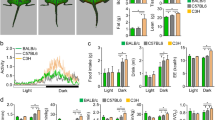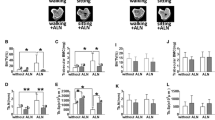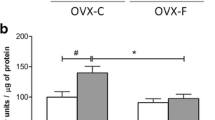Abstract
Osteocalcin, known as a bone gla protein, is considered a regulator of energy metabolism and behavior in its undercarboxylated form (ucOC). Antiresorptive drugs, such as alendronate, reduce serum level of ucOC. The purpose of the current study was to verify if alendronate might impact on energy metabolism and animal behavior by reducing ucOC level and to find out if the presence of metabolic alterations would further worsen these potential adverse effects. Four groups of male Wistar rats (12 per group) were used: a control group, a group receiving high-fat high-fructose diet (HFHF), a group treated with alendronate, and a group receiving alendronate and HFHF. Alendronate was administered subcutaneously in a dose of 50 mcg/kg thrice weekly. Study duration was 15 weeks. Animals were tested for locomotion, anxiety and spatial memory. Glucose and insulin tolerance tests evaluated the glucose metabolism. Visceral obesity was assessed by the weight of right retroperitoneal fat pads. Concentration of ucOC was measured in the serum. Alendronate reduced serum ucOC concentration, increased fasting blood glucose level, and worsened insulin sensitivity. It did not increase visceral adiposity. Fat index was negatively correlated with ucOC in all animals and in the alendronate-treated rats. Alendronate worsened spatial memory of the animals and ucOC levels correlated positively with their cognitive performance.





Similar content being viewed by others
References
Hauschka PV, Lian JB, Cole DE, Gundberg CM (1989) Osteocalcin and matrix Gla protein: vitamin K-dependent proteins in bone. Physiol Rev 69(3):990–1047. https://doi.org/10.1152/physrev.1989.69.3.990
Morris DP, Stevens RD, Wright DJ, Stafford DW (1995) Processive post-translational modification. Vitamin K-dependent carboxylation of a peptide substrate. J Biol Chem 270:30491–30498. https://doi.org/10.1074/jbc.270.51.30491
Ducy P (2011) The role of osteocalcin in the endocrine cross-talk between bone remodelling and energy metabolism. Diabetologia 54(6):1291–1297. https://doi.org/10.1007/s00125-011-2155-z
Lee N, Sowa H, Hinoi E, Ferron M, Ahn J, Confavreux C, Dacquin R, Mee P, McKee M, Jung D, Zhang Z, Kim J, Mauvais-Jarvis F, Ducy P, Karsenty G (2007) Endocrine regulation of energy metabolism by the skeleton. Cell 130(3):456–469. https://doi.org/10.1016/j.cell.2007.05.047
Ferron M, Hinoi E, Karsenty G, Ducy P (2008) Osteocalcin differentially regulates beta cell and adipocyte gene expression and affects the development of metabolic diseases in wild-type mice. Proc Natl Acad Sci USA 105:5266–5270. https://doi.org/10.1073/pnas.0711119105
Ferron M, McKee M, Levine R, Ducy P, Karsenty G (2012) Intermittent injections of osteocalcin improve glucose metabolism and prevent type 2 diabetes in mice. Bone 50(2):568–575. https://doi.org/10.1016/j.bone.2011.04.017
Gancheva S, Galunska B, Zhelyazkova-Savova M (2015) Osteocalcin in a rat model of metabolic syndrome. Adipobiology 7:31–36. https://doi.org/10.14748/adipo.v7.1558
Confavreux CB, Szulc P, Casey R, Varennes A, Goudable J, Chapurlat RD (2014) Lower serum osteocalcin is associated with more severe metabolic syndrome in elderly men from the MINOS cohort. Eur J Endocrinol 171(2):275–283. https://doi.org/10.1530/EJE-13-0567
Razny U, Fedak D, Kiec-Wilk B, Goralska J, Gruca A, Zdzienicka A, Kiec-Klimczak M, Solnica B, Hubalewska-Dydejczyk A, Malczewska-Malec M (2017) Carboxylated and undercarboxylated osteocalcin in metabolic complications of human obesity and prediabetes. Diabetes Metab Res Rev 33:e2862. https://doi.org/10.1002/dmrr.2862
Lacombe J, Al Rifai O, Loter L, Moran T, Turcotte AF, Grenier-Larouche T, Tchernof A, Biertho L, Carpentier AC, Prud'homme D, Rabasa-Lhoret R, Karsenty G, Gagnon C, Jiang W, Ferron M (2020) Measurement of bioactive osteocalcin in humans using a novel immunoassay reveals association with glucose metabolism and β-cell function. Am J Physiol Endocrinol Metab 318(3):E381–E391. https://doi.org/10.1152/ajpendo.00321.2019
Oury F, Khrimian L, Denny CA, Gardin A, Chamouni A, Goeden N, Huang YY, Lee H, Srinivas P, Gao XB, Suyama S, Langer T, Mann JJ, Horvath TL, Bonnin A, Karsenty G (2013) Maternal and offspring pools of osteocalcin influence brain development and functions. Cell 155:228–241. https://doi.org/10.1016/j.cell.2013.08.042
Khrimian L, Obri A, Ramos-Brossier M, Rousseaud A, Moriceau S, Nicot AS, Mera P, Kosmidis S, Karnavas T, Saudou F, Gao X, Oury F, Kandel E, Karsenty G (2017) Gpr158 mediates osteocalcin's regulation of cognition. J Exp Med 214(10):2859–2873. https://doi.org/10.1084/jem.20171320
Luppino F, de Wit L, Bouvy P, Stijnen T, Cuijpers P, Penninx B, Zitman F (2010) Overweight, obesity, and depression a systematic review and meta-analysis of longitudinal studies. Arch Gen Psychiatry 67(3):220–229. https://doi.org/10.1001/archgenpsychiatry.2010.2
Gariepy G, Nitka D, Schmitz N (2010) The association between obesity and anxiety disorders in the population: a systematic review and meta-analysis. Int J Obes (Lond) 34:407–419. https://doi.org/10.1038/ijo.2009.252
Anstey KJ, Cherbuin N, Budge M, Young J (2011) BMI in midlife and late life as a risk for dementia: a meta-analysis of prospective studies. Obesity Rev 12:e426–437. https://doi.org/10.1111/j.1467-789X.2010.00825.x
Gancheva S, Galunska B, Zhelyazkova-Savova M (2017) Diets rich in saturated fat and fructose induce anxiety and depression-like behaviors: is there a role for lipid peroxidation? Int J Exp Pathol 98(5):296–306. https://doi.org/10.1111/iep.12254
Yamada-Goto N, Katsuura G, Nakao K (2013) Mental function and obesity. In: Signorelli R and Chirchiglia D (eds) Functional brain mapping and the endeavor to understand the working brain. IntechOpen. https://doi.org/10.5772/56228
Mokuda S, Okuda Y, Onishi M, Sawada N, Matoba K, Yamada A, Jouyama K, Takasugi K (2012) Post-menopausal women with rheumatoid arthritis who are treated with raloxifene or alendronate or glucocorticoids have lower serum undercarboxylated osteocalcin levels. J Endocrinol Invest 35(7):661–664
Hirao M, Hashimoto J, Ando W, Ono T, Yoshikawa H (2008) Response of serum carboxylated and undercarboxylated osteocalcin to alendronate monotherapy and combined therapy with vitamin K2 in postmenopausal women. J Bone Miner Metab 26(3):260–264. https://doi.org/10.1007/s00774-007-0823-3
Aonuma H, Miyakoshi N, Hongo M, Kasukawa Y, Shimada Y (2009) Low serum levels of undercarboxylated osteocalcin in postmenopausal osteoporotic women receiving an inhibitor of bone resorption. Tohoku J Exp Med 218(3):201–205. https://doi.org/10.1620/tjem.218.201
Chan DC, Yang RS, Ho CH, Tsai YS, Wang JJ, Tsai KT (2015) The use of alendronate is associated with a decreased incidence of type 2 diabetes mellitus—a population-based cohort study in Taiwan. PLoS ONE 10(4):e0123279. https://doi.org/10.1371/journal.pone.0123279
Schafer AL, Sellmeyer DE, Schwartz AV, Rosen CJ, Vittinghoff E, Palermo L, Bilezikian JP, Shoback DM, Black DM (2011) Change in undercarboxylated osteocalcin is associated with changes in body weight, fat mass, and adiponectin: parathyroid hormone (1–84) or alendronate therapy in postmenopausal women with osteoporosis (the PaTH study). J Clin Endocrinol Metab 96(12):E1982–1989. https://doi.org/10.1210/jc.2011-0587
Schwartz AV, Schafer AL, Grey A, Vittinghoff E, Palermo L, Lui LY, Wallace RB, Cummings SR, Black DM, Bauer DC, Reid IR (2013) Effects of antiresorptive therapies on glucose metabolism: results from the FIT, HORIZON-PFT, and FREEDOM trials. J Bone Miner Res 28(6):1348–1354. https://doi.org/10.1002/jbmr.1865
Toulis KA, Nirantharakumar K, Ryan R, Marshall T, Hemming K (2015) Bisphosphonates and glucose homeostasis: a population-based, retrospective cohort study. J Clin Endocrinol Metab 100(5):1933–1940. https://doi.org/10.1210/jc.2014-3481
Pytlik M, Kaczmarczyk-Sedlak I, Sliwiński L, Janiec W, Rymkiewicz I (2004) Effect of concurrent administration of alendronate sodium and retinol on development of changes in histomorphometric parameters of bones induced by ovariectomy in rats. Pol J Pharmacol 56(5):571–579
Chen BL, Xie DH, Zheng ZM, Lu W, Ning CY, Li YQ, Li FB, Liao WM (2011) Comparison of the effects of alendronate sodium and calcitonin on bone-prosthesis osseointegration in osteoporotic rats. Osteoporos Int 22(1):265–270. https://doi.org/10.1007/s00198-010-1186-5
Fuchs RK, Shea M, Durski SL, Winters-Stone KM, Widrick J, Snow CM (2007) Individual and combined effects of exercise and alendronate on bone mass and strength in ovariectomized rats. Bone 41(2):290–296. https://doi.org/10.1016/j.bone.2007.04.179
Lacombe J, Karsenty G, Ferron M (2013) In vivo analysis of the contribution of bone resorption to the control of glucose metabolism in mice. Mol Metab 2(4):498–504. https://doi.org/10.1016/j.molmet.2013.08.004
Fluttert M, Dalm S, Oitzl M (2000) A refined method for sequential blood sampling by tail incision in rats. Lab Anim 34:372–378. https://doi.org/10.1258/002367700780387714
Gould TD, Dao DT, Kovacsics CE (2009) The open field test. In: Gould TD (ed) Mood and anxiety related phenotypes in mice: characterization using behavioral tests. Springer, Berlin, pp 1–20
File S, Hyde J (1978) Can social interaction be used to measure anxiety? Br J Pharmac 62:19–24. https://doi.org/10.1111/j.1476-5381.1978.tb07001.x
Vogel-Ciernia A, Wood MA (2014) Examining object location and object recognition memory in mice. Curr Protoc Neurosci. https://doi.org/10.1002/0471142301.ns0831s69
Lin JH, Chen IW, deLuna FA (1994) On the absorption of alendronate in rats. J Pharm Sci 83(12):1741–1746. https://doi.org/10.1002/jps.2600831218
Sama AA, Khan SN, Myers ER, Huang RC, Cammisa FP Jr, Sandhu HS, Lane JM (2004) High-dose alendronate uncouples osteoclast and osteoblast function: a study in a rat spine pseudarthrosis model. ClinOrthopRelat Res 425:135–142. https://doi.org/10.1097/00003086-200408000-00018
Astrand J, Aspenberg P (2002) Systemic alendronate prevents resorption of necrotic bone during revascularization* A bone chamber study in rats. BMC Musculoskelet Disord 3:19. https://doi.org/10.1186/1471-2474-3-19
Samra RA (2010) Fats and satiety. Fat detection. In: Montmayeur JP, le Coutre J (eds) Taste, texture, and post ingestive effects. CRC Press, Boca Raton
Bowe JE, Franklin ZJ, Hauge-Evans AC, King AJ, Persaud SJ, Jones PM (2014) Metabolic phenotyping guidelines: assessing glucose homeostasis in rodent models. J Endocrinol 222(3):G13–25. https://doi.org/10.1530/JOE-14-0182
Hong S-H, Koo J-W, Hwang J-K, Hwang Y-C, Jeong I-K, Ahn KJ, Chung H-Y (2013) Changes in serum osteocalcin are not associated with changes in glucose or insulin for osteoporotic patients treated with bisphosphonate. J Bone Metab 20(1):37–41. https://doi.org/10.11005/jbm.2013.20.1.37
Kaji H, Hisa I, Inoue Y, Naito J, Sugimoto T, Kasuga M (2009) Analysis of factors affecting increase in bone mineral density at lumbar spine by bisphosphonate treatment in postmenopausal osteoporosis. J Bone Miner Metab 27(1):76–82. https://doi.org/10.1007/s00774-008-0005-y
Vestergaard P (2011) Risk of newly diagnosed type 2 diabetes is reduced in users of alendronate. Calcif Tissue Int 89(4):265–270. https://doi.org/10.1007/s00223-011-9515-z
Karimi Fard M, Aminorroaya A, Kachuei A, Salamat MR, Hadi Alijanvand M, AminorroayaYamini S, Karimifar M, Feizi A, Amini M (2019) Alendronate improves fasting plasma glucose and insulin sensitivity, and decreases insulin resistance in prediabeticosteopenic postmenopausal women: a randomized triple-blind clinical trial. J Diabetes Investig 10(3):731–737. https://doi.org/10.1111/jdi.12944
Citraro R, Gallelli L, Leo A, De Fazio P, Gallelli P, Russo E, De Sarro G (2015) Effects of chronic sodium alendronate on depression and anxiety in a menopausal experimental model. Pharmacol Biochem Behav 129:65–71. https://doi.org/10.1016/j.pbb.2014.12.006
Mollard E, Bilek L, Waltman N (2018) Emerging evidence on the link between depressive symptoms and bone loss in postmenopausal women. Int J Womens Health 10:1–9. https://doi.org/10.2147/IJWH.S147006
Sohrabi HR, Bates KA, Weinborn M, Bucks RS, Rainey-Smith SR, Rodrigues MA, Bird SM, Brown BM, Beilby J, Howard M, Criddle A, Wraith M, Taddei K, Martins G, Paton A, Shah T, Dhaliwal SS, Mehta PD, Foster JK, Martins IJ, Lautenschlager NT, Mastaglia F, Laws SM, Martins RN (2015) Bone mineral density, adiposity, and cognitive functions. Front Aging Neurosci 7:16. https://doi.org/10.3389/fnagi.2015.00016
Safer U, Safer VB, Demir SO, Yanikoglu I (2016) Effects of bisphosphonates and calcium plus vitamin-d supplements on cognitive function in postmenopausal osteoporosis. Endocr Metab Immune Disord Drug Targets 16(1):56–60. https://doi.org/10.2174/1871530316666160330105952
Tasci I, Safer U, Cintosun U, Bozoglu E, Naharci I, Aydogdu A, Meric C, Doruk H (2016) Zoledronic acid use and risk of cognitive decline among elderly women and men with osteoporosis. Endocr Metab Immune Disord Drug Targets 16(1):32–38. https://doi.org/10.2174/1871530315666151104115829
Gokosmanoglu F, VarimC AA, Atmaca MH, Colak R (2016) The effects of zoledronic acid treatment on depression and quality of life in women with postmenopausal osteoporosis: a clinical trial study. J Res Med Sci 21:112. https://doi.org/10.4103/1735-1995.193503
Funding
The current study is supported by Science Fund of Medical University of Varna, Bulgaria (Grant No. 15004).
Author information
Authors and Affiliations
Contributions
MZ designed the study, SG and MZ contributed to the experimental work and statistical analysis. SG prepared the first draft of the paper. MZ revised the paper.
Corresponding author
Ethics declarations
Conflict of interest
Silvia Gancheva and Maria Zhelyazkova-Savova declare that they have no conflict of interest.
Human and Animal Rights and Informed Consent
The study was performed on experimental animals. The use of experimental animals was ethically approved by the Commission of Foods Safety in the Bulgarian Ministry of Agriculture and Foods (Document No. 140/2016) and was conducted in agreement with the National Policies and the Council Directive (2010/63/EU). Informed consent statement about human rights is not applicable.
Additional information
Publisher's Note
Springer Nature remains neutral with regard to jurisdictional claims in published maps and institutional affiliations.
Rights and permissions
About this article
Cite this article
Gancheva, S., Zhelyazkova-Savova, M. Are Bisphosphonates Associated with Adverse Metabolic and Cognitive Effects? A Study in Intact Rats and Rats Fed High-Fat High-Fructose Diet. Calcif Tissue Int 107, 41–51 (2020). https://doi.org/10.1007/s00223-020-00684-5
Received:
Accepted:
Published:
Issue Date:
DOI: https://doi.org/10.1007/s00223-020-00684-5




